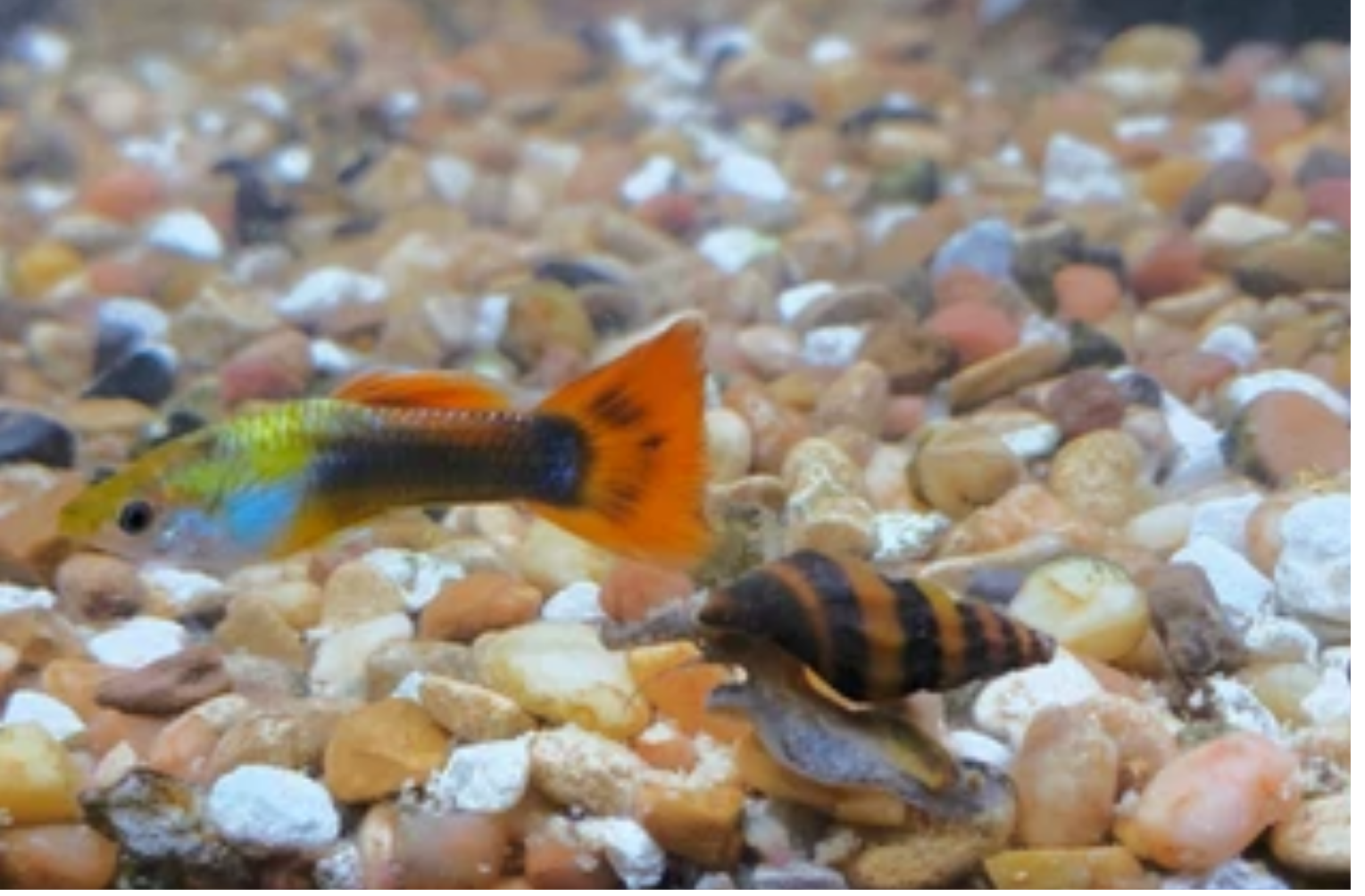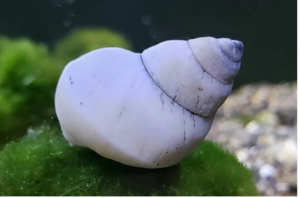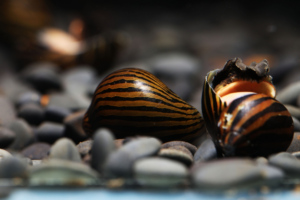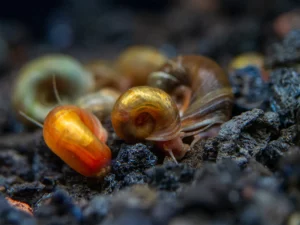The name “Assassin” may not be suitable for an indoor tank snail, as it can evoke fear in aquarists. However, these snails are beneficial, appealing, and fascinating to observe in the appropriate aquarium.
Assassin snails are carnivores that initially feed on other tank pets. They thrive in tank water temperatures of 20-27°C (68°-80°F), pH levels of 7.0-6.5, hardness levels of 6-18kH, and regular community lighting. The snails breed sexually, with the female laying eggs on hard tank surfaces.
This guide takes you on a journey through the world of caring for assassin snails. You will discover the ideal tank setup, breeding habits, suitable tank mates, common issues, as well as their origin and natural habitat.
Assassin Snail Origin and Habitat

So, where did this combative snail species come from? Assassin snails (Clea Helena) are endemic to the tropical freshwater bodies of Southeast Asia.
They originated from regions such as:
- Malaysia
- Sumatra
- Thailand
- Vietnam
Their popularity in the commercial trade has grown from these areas. Belonging to the Nassariidae family and Clea group, which comprises only 10 known species, this snail is also commonly known as the bumblebee snail due to its distinctive brown and yellow pattern.
In the wild, assassin snails thrive in tropical freshwater habitats such as:
- Canals
- Lakes
- Streams
- Rivers
They prefer warm, sandy environments with slow-moving water. These nocturnal burrowers spend most of their day concealed beneath the substrate, emerging at night to hunt their prey.
Despite their sluggish nature, assassin snails employ an effective ambush hunting technique, which remains a mystery as to how they manage to eliminate other snails in a tank.
Assassin Snail Appearance and Size
| Characteristic | Description |
| Shell Appearance | Long, gold-colored spiral shell without distinct whorl patterns. Yellow and dark brown stripes resembling a bumblebee pattern. |
| Antennas | Short antennas on either side of the head. Similar in shape for both males and females. |
| Siphon | Fresh tube extending from the top of the head. Facilitates breathing and acts as a sensory organ. |
| Size | Captivity: Up to 1.7 cm (0.7 inches) in diameter and 2.5 cm (1 inch) in length Wild: Up to 3 cm (1.2 inches) in diameter and 4 cm (1.5 inches) in length |
| Gender Difference | Females tend to be slightly larger than males. |
Assassin snails are easily identifiable by their unique appearance. They possess a long, gold-colored spiral shell without distinct whorl patterns. Dark brown and yellow stripes encircle the shell, giving it a bumblebee-like appearance, hence the alternative name “bumblebee snail.”
Each snail has short antennas on either side of its head, which have similar shapes in both males and females, making it impossible to distinguish their genders based on antennae alone.
In addition to the shell, the snail’s siphon is another distinguishing feature. This fresh tube extends from the top of its head, serving the purposes of respiration while buried in sand and detecting movement as a sensory organ.
The siphon plays a crucial role in both hunting and defense. When another snail approaches the siphon, the assassin snail swiftly reacts by capturing its prey. If faced with a predator, the snail quickly retreats into its shell, using a well-developed operculum as a trap door to seal its vulnerable interior.
Assassin snails are relatively small, yet their impact on tank mates can be significant. In captivity, they typically grow to an average diameter of 0.7 inches (1.8 cm) and a length of 1 inch (2.5 cm).
In more favorable conditions in the wild, these snails can reach a diameter of up to 1.2 inches (3 cm) and a length of 1.5 inches (3.8 cm). Females tend to be slightly larger than males.
Buying an Assassin Snail
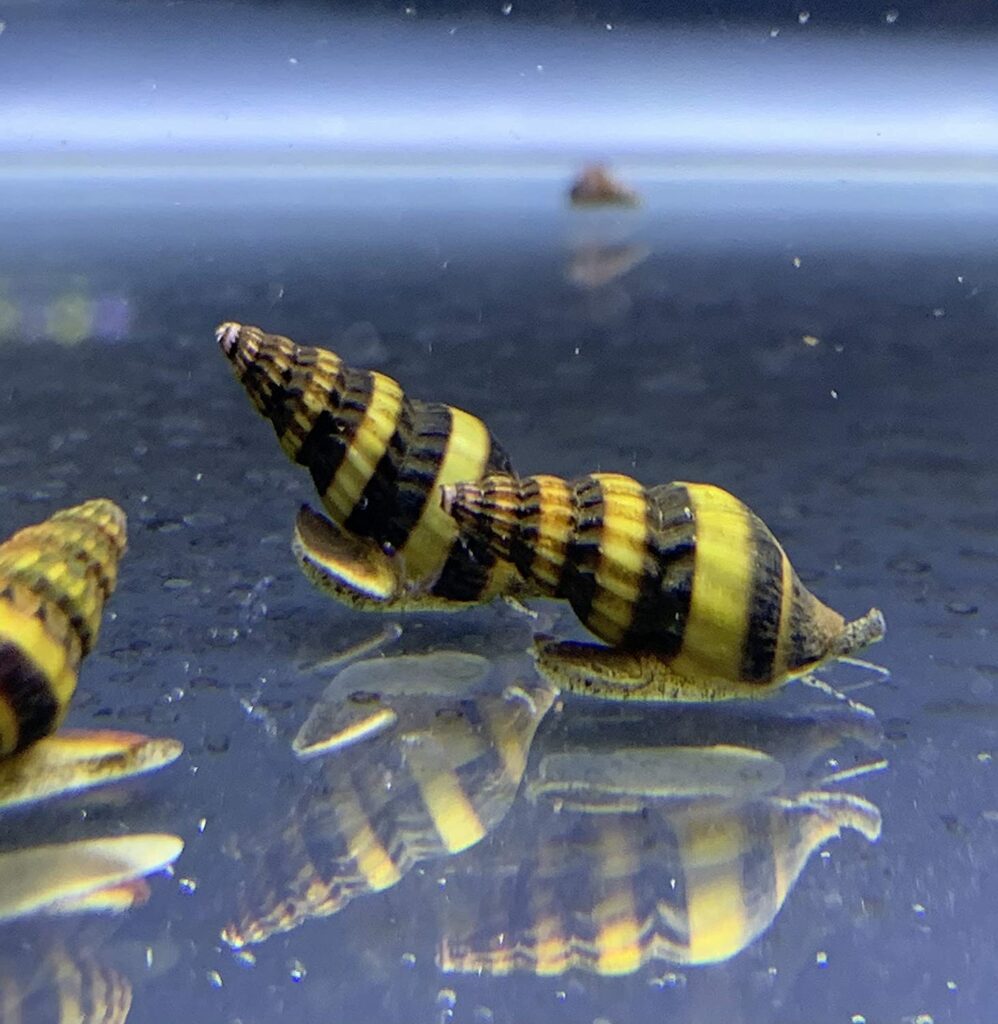
I recommend purchasing Assassin Snails from Amazon, specifically the Assassin Snails x3 (Clea Helena) 1/2″ to 3/4″. To ensure the safe delivery of the snails, it’s important to select Priority Mail Shipping at checkout, which guarantees delivery within 1-3 days.
| Preview | Product | |
|---|---|---|

|
Assassin Snails x3 (Clea Helena) 1/2″ to 3/4″ Live Freshwater Snail Plants | Check Price |
Consider the following before buying an assassin snail:
- Look for the gold-colored spiral shell with unique dark brown and yellow stripes.
- Check for the presence of a siphon or pair of tentacles.
- Ensure the shells are free from damage like cracks or splits.
- Observe if the snails have a firmly attached operculum on the upper surface of their foot.
- Avoid purchasing assassin snails from tanks with unhealthy populations.
It’s important to note that assassin snails are sexually monomorphic, meaning males and females look identical. There are no distinguishing secondary traits.
To ensure a mix of males and females, it’s advisable to purchase a larger group of approximately six snails.
Assassin Snail Lifespan
A common question among enthusiasts is the lifespan of assassin snails as pets at home. This snail species can typically live up to 2 years under normal captive conditions.
However, with exceptional water quality and a nutritious diet, their lifespan may be slightly extended. Conversely, poor water quality and inadequate nourishment can shorten their lifespan to 1.5 years.
In the wild, assassin snails can live up to 4 years due to the abundance of food and the ability to escape unsuitable water conditions.
Assassin Snail Care
Tank Size
For optimal care, I recommend a tank size of at least 5 gallons (19 liters) per assassin snail. However, to effectively rear assassin snails and accommodate the necessary 5-6 snails for breeding purposes, a minimum tank size of 30 gallons (114 liters) is required.
The larger tank size is essential due to their feeding habits on other tank pets, which need to coexist in the same tank. Larger tanks are better equipped to handle sudden changes in water parameters, increasing the chances of pet survival.
If you’re a beginner, I recommend the SeaClear 30-gallon Acrylic Aquarium from Amazon. This tank set includes a reflector and a 24″ lighting fixture, providing excellent illumination. The bezel-less wide-view design offers an immersive viewing experience, and the Black Nano Foam Leveling mat protects the tank from potential damage.
Optimum Tank Parameters
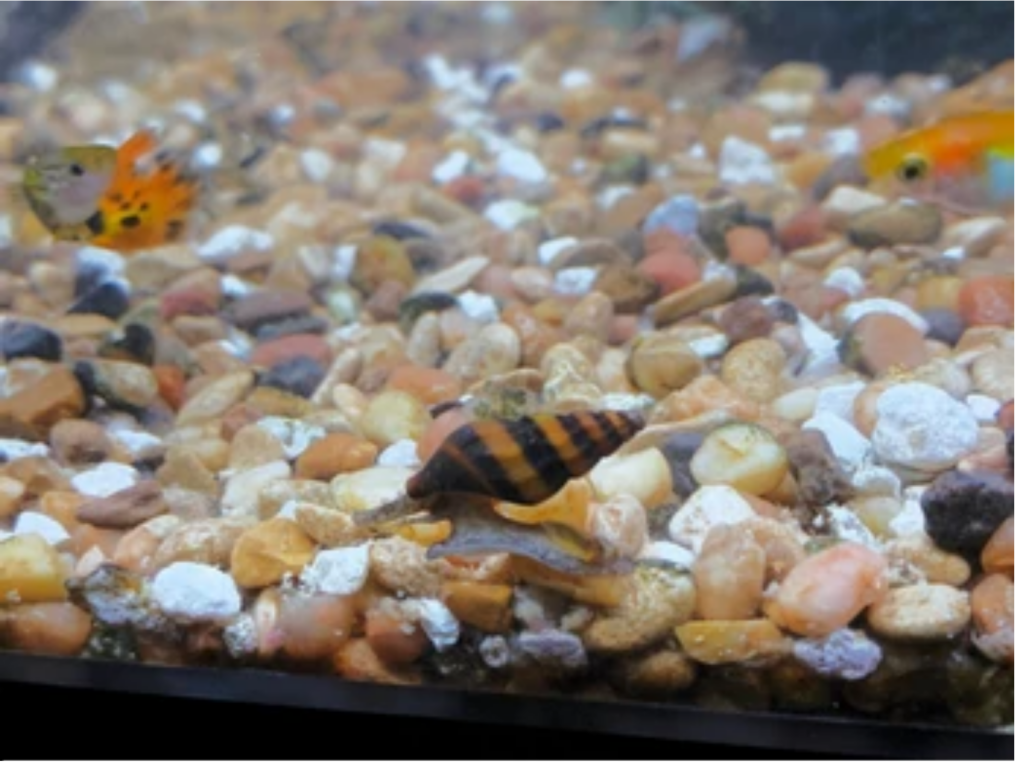
To ensure the well-being of your assassin snail, it is important to maintain the following optimum water parameters:
| Parameter | Range |
| Temperature | 68°F-80°F (20°C-27°C) |
| Ammonia/Nitrite | 0 |
| pH | 7.0-6.5 |
| Hardness | 6-18 kH |
| Lighting | Normal community tank lighting |
The wide range of acceptable temperatures and hardness levels highlights the adaptability of assassin snails. However, maintaining parameter consistency is crucial for their health.
To monitor parameter changes, I recommend using the SJ WAVE 7-in-1 Aquarium Test Kit from Amazon. This kit allows you to regularly assess important factors such as copper and ammonia levels, which can be lethal to aquarium snails.
| Preview | Product | |
|---|---|---|

|
SJ WAVE 7 in 1 Aquarium Test Kit for Freshwater Aquarium | Fast & Accurate Water Quality Testing… | Check Price |
Related Reading: Can You Use ParaGuard with Snails?
Substratum
The ideal substrate for assassin snails is soft sand or aqua soil. Being burrowing species, these snails spend a significant amount of time digging into the tank floor in search of food. It is normal for them to completely bury themselves in the sand, so there is no cause for concern in such instances.
However, prolonged burial should be monitored closely. Avoid using gravel or coarse sand as substrates, as they are too rough and can potentially injure the snails.
Related Reading: Can Snails Feel Pain?
Plants and Décor
While assassin snails are primarily carnivorous and show no interest in plants, having a planted tank can still be beneficial.
Aquarium plants contribute to the overall health of the tank’s ecosystem by providing additional food sources for snails and promoting algae growth, which in turn increases the available food for assassin snails.
Additionally, incorporating various tank decorations can enrich these snails, as they enjoy interacting with the decor. Rest assured, assassin snails will not harm aquarium plants or decorations.
Special lighting is unnecessary for assassin snails, as they are nocturnal creatures. They can tolerate different lighting conditions, but they generally prefer to avoid very bright lights.
Diet
Keeping assassin snails well-fed should not be a challenge. This snail species feeds on other aquarium pets, and provided the aquarium is well-stocked, assassin snails will sort themselves.
However, the assassin snails will eventually wipe out other small tank inhabitants and require a supplemental diet. If these supplemental foods are not provided, the snails might starve to death.
Consider high-protein foods such as:
- Snail eggs
- Water fleas
- Bloodworms
- Fresh slices of fish
- Blackworms
- Flake food
Assassin snails will eat algae, although it is not their top priority. However, high-protein algae wafers such as Omega One Veggie Rounds from Amazon can be beneficial. The high protein content in these rounds keeps your assassin snails going for days without the need for other supplemental foods.
Also, consider giving your assassin snails adequate amounts of calcium for healthy shell development. Occasionally, putting calcium pellets into your tank is a good idea.
I recommend using the Seachem Reef Calcium 500 ml from Amazon. This blend releases calcium and other vital elements to support plant and animal growth. The blend is easy to use and environmentally friendly. Frequent use as directed will ensure that your snails are adequately nourished with calcium.
| Preview | Product | |
|---|---|---|

|
Seachem Reef Calcium 500ml | Check Price |
Breeding
The assassin snail is not hermaphroditic. It reproduces sexually through the mating of a male and female snail.
Related Reading: How Do Snails Reproduce?
Unlike most other snail species, the assassin snail does not self-fertilize. Mating in this species requires effort and time.
I recommend buying at least five assassin snails from the pet store to ensure you have at least one male and one female in your tank.
Additionally, feed them appropriately to stimulate the desire to mate. If you are keen and observant, you will notice one snail mounting the other for several hours, which indicates mating in assassin snails.
A few days later, you will see the female assassin snail laying eggs and attaching them to hard surfaces by gliding along. Females prefer to lay their eggs in darker regions, such as crevices, to hide them.
The eggs are usually separate from each other and take 3-8 weeks to hatch. A female assassin snail can lay up to 20 eggs at once.
Approximately two months after hatching, you will be able to see tiny assassin snails moving around the tank. However, be cautious about assassin snail populations in your tank growing out of control, as this can create feeding challenges.
Tank Mates
Assassin snails can be housed with semi-aggressive or aggressive tank pets. These snails can discern who to avoid and when to avoid them.
While it is common to witness assassin snails being harassed by larger aggressive fish and loaches, it is also not unusual to see these snails harassing shrimp.
To maintain a harmonious tank environment, avoid mixing assassin snails with the following snail predators:
- Gourami
- Betta fish
- Goldfish
- Catfish
- Yoyo loach
- Clown roach
- Bala shark
On the other hand, assassin snails will devour the following freshwater snail species:
However, larger snails of the species mentioned above might have a chance of survival as assassin snails can be intimidated by their size.
One major disadvantage of the assassin snail is its sluggishness. These snails do not actively pursue their prey and rely solely on ambush hunting.
However, younger snails and fish would be quite vulnerable in a tank with a significant population of assassin snails.
Assassin Snail Common Problems
Although assassin snails are generally adaptable, young snails may not tolerate sudden shifts in water parameters. Therefore, it is important to have a filter and heater and regularly monitor water parameters. This species also prefers a mature tank.
Common health problems observed in assassin snails include:
- Stunted growth: This occurs when the snails do not receive sufficient food or when the tank parameters are not optimal.
- Brittle shell: Inadequate calcium levels and poor water quality can lead to shell discoloration, weakness, and cracking.
- Parasitic infections: Flukes and leeches are the main culprits behind these infections, resulting in white spots on the shell and general snail lethargy.
To prevent the spread of infections, it is essential to promptly quarantine any sick snail.
Also Read: Can Snails Get Fish TB?
Closing Remarks
While assassin snails can be ferocious towards other freshwater snails, they pose no harm to humans or larger aquatic creatures. When they feel threatened, they will retreat into their shells.
These snails are an excellent choice for aquarists dealing with snail infestations, as they can effectively clear pest snails within a few months.
I hope this information has provided you with valuable insights to successfully rear assassin snails and utilize them to clear your tank.
Let me hear your thoughts in the comments box below.
